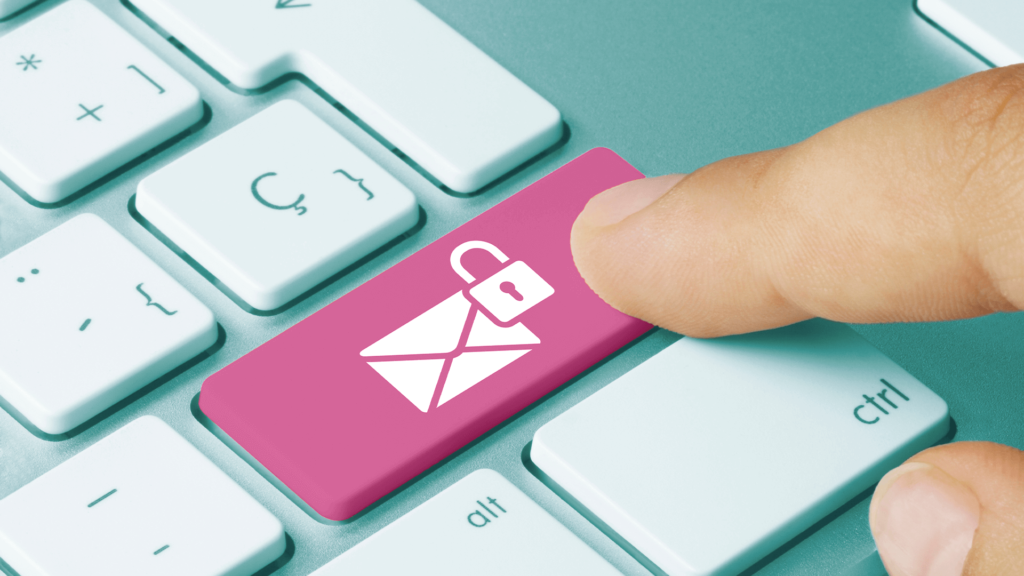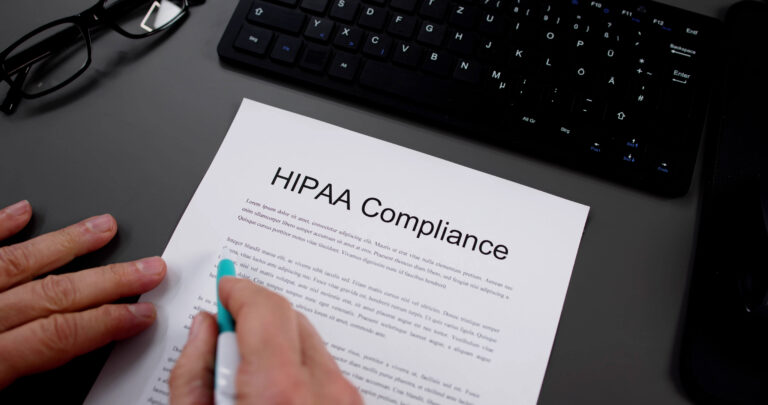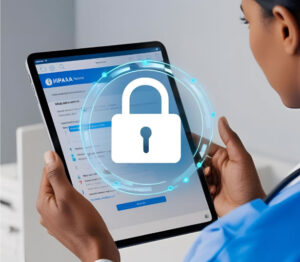In today’s digital age, healthcare providers face an ever-growing challenge: maintaining patient privacy while leveraging technology to improve care. The Health Insurance Portability and Accountability Act (HIPAA) sets the standard for protecting sensitive patient data, but navigating its complexities can be daunting. This comprehensive guide will equip you with the knowledge and tools necessary to master HIPAA-compliant communications, ensuring both legal compliance and optimal patient care.
The Importance of HIPAA Compliance and Email in Healthcare Communications
As healthcare providers, we bear a significant responsibility to protect our patients’ sensitive information. HIPAA compliance when sending emails and other communication isn’t just a legal obligation; it’s a fundamental aspect of maintaining trust and providing quality care. When patients know their information is secure, they’re more likely to be open and honest about their health concerns, leading to better diagnoses and treatment outcomes.
Consider this: A single HIPAA violation can result in fines ranging from $100 to $50,000 per violation, with a maximum penalty of $1.5 million per year for repeated violations. Beyond the financial impact, breaches can severely damage your reputation and patient relationships. By prioritizing HIPAA-compliant communications, you’re not only protecting your practice but also demonstrating your commitment to patient privacy and professional integrity.
Understanding the Basics of HIPAA: What Healthcare Providers Need to Know
Before diving into specific strategies for HIPAA-compliant communications, it’s crucial to understand the fundamental principles of HIPAA. The Act consists of several rules, but for our purposes, we’ll focus on the Privacy Rule and the Security Rule.
The Privacy Rule establishes national standards for the protection of individuals’ medical records and other personal health information. It requires appropriate safeguards to protect the privacy of personal health information and sets limits and conditions on the uses and disclosures that may be made of such information without patient authorization.
Key points of the Privacy Rule include:
- Giving patients rights over their health information, including the right to examine and obtain a copy of their health records and to request corrections
- Requiring healthcare providers to notify patients about how their information may be used and shared
- Limiting the use and disclosure of protected health information (PHI) to the minimum necessary for the intended purpose
- Establishing appropriate administrative, physical, and technical safeguards to ensure the confidentiality of electronic protected health information (ePHI)
The Security Rule complements the Privacy Rule by specifically focusing on the safeguarding of electronic protected health information (ePHI). It requires covered entities to implement appropriate administrative, physical, and technical safeguards to ensure the confidentiality, integrity, and security of ePHI.
Key aspects of the Security Rule include:
- Ensuring the confidentiality, integrity, and availability of all ePHI created, received, maintained, or transmitted
- Identifying and protecting against reasonably anticipated threats to the security or integrity of the information
- Protecting against reasonably anticipated, impermissible uses or disclosures
- Ensuring compliance by their workforce
Understanding these basic principles is essential for implementing effective HIPAA-compliant communication strategies in your healthcare practice.

Common Challenges in Achieving HIPAA Compliance for Communications
While the importance of HIPAA compliance and email is clear, many healthcare providers face significant challenges in implementing and maintaining compliant communication practices. Let’s explore some of the most common hurdles:
- Lack of awareness and training: Many healthcare professionals are not fully aware of HIPAA requirements or how they apply to day-to-day communications. This knowledge gap can lead to unintentional violations.
- Outdated technology: Some healthcare providers still rely on outdated communication systems that may not meet HIPAA security standards, making it difficult to protect patient information adequately.
- Mobile device usage: The increasing use of personal smartphones and tablets for work-related communications can create security vulnerabilities if not properly managed.
- Email security: Standard email services often lack the necessary encryption and security features to be HIPAA-compliant, yet many providers still use them for patient communications.
- Third-party vendors: Working with external service providers who may not be HIPAA-compliant can put patient data at risk.
- Patient expectations: In an age of instant communication, patients often expect quick responses through convenient channels, which may not always align with HIPAA requirements.
- Cost of compliance: Implementing and maintaining HIPAA-compliant systems and processes can be expensive, particularly for smaller practices.
- Evolving technology landscape: As new communication technologies emerge, staying compliant with HIPAA regulations becomes an ongoing challenge.
- Balancing efficiency and compliance: Providers often struggle to maintain efficient workflows while adhering to strict HIPAA guidelines.
- Documentation and auditing: Keeping thorough records of compliance efforts and conducting regular audits can be time-consuming and complex.
Recognizing these challenges is the first step toward overcoming them. In the following sections, we’ll explore strategies and best practices to address these issues and ensure HIPAA-compliant communications in your healthcare practice.
Secure Email and Messaging: Best Practices for HIPAA-Compliant Channels
Email and instant messaging have become integral to healthcare communications, but standard platforms often fall short of HIPAA requirements. To ensure compliance, consider the following best practices:
- Use encrypted email services: Invest in a HIPAA-compliant email service that offers encryption in transit and at rest. This ensures that even if an unauthorized party intercepts the email, they cannot read its contents.
- Implement secure messaging platforms: Utilize HIPAA-compliant messaging apps designed specifically for healthcare providers. These platforms often include features like message expiration, remote recall capabilities, and audit trails.
- Establish clear policies: Develop and enforce policies regarding the use of email and messaging for patient communications. Clearly define what types of information can be shared through these channels and under what circumstances.
- Train staff regularly: Conduct ongoing training sessions to ensure all staff members understand and follow HIPAA-compliant communication practices.
- Use secure patient portals: Implement a secure patient portal for sharing test results, form submissions, appointment information, and other sensitive data. This provides a safe, HIPAA-compliant alternative to email for many types of patient communications.
- Double-check recipient information: Before sending any email or message containing protected health information, verify the recipient’s identity and contact information to prevent accidental disclosures.
- Avoid using personal email accounts: Ensure that all staff members use only approved, HIPAA-compliant email accounts for work-related communications.
- Implement strong authentication measures: Use user authentication with strong passwords for accessing email and messaging platforms to add an extra layer of security.
- Regularly update and patch systems: Keep all communication systems and software up-to-date with the latest security patches to protect against vulnerabilities.
- Use secure file transfer protocols or secure messaging portals: When sharing large files or datasets, use secure file transfer protocols rather than email attachments or use secure messaging portals that support encryption and large file attachments.
By implementing these best practices, you can significantly reduce the risk of HIPAA violations while maintaining efficient communication channels with patients and colleagues.

Protecting Patient Privacy: Strategies for Safeguarding Sensitive Information
Protecting patient privacy goes beyond secure communications; it encompasses all aspects of how you handle and store patient information. Here are key strategies to safeguard sensitive data:
- Implement access controls: Use role-based access control to ensure staff members can only access the minimum necessary patient information required for their job functions.
- Encrypt all devices: Use full-disk encryption on all computers, laptops, tablets, and smartphones that may contain or access patient information.
- Develop a robust password policy: Require strong, unique passwords for all accounts and systems. Consider implementing a password manager to help staff maintain secure passwords.
- Use secure Wi-Fi: Ensure that your office Wi-Fi network is encrypted and password-protected. Avoid using public Wi-Fi networks for accessing or transmitting patient information.
- Implement physical safeguards: Secure physical records in locked cabinets, use privacy screens on monitors, and control access to areas where patient information is stored or accessed.
- Conduct regular security audits: Perform periodic assessments of your security measures to identify and address any vulnerabilities.
- Develop a data retention and destruction policy: Establish clear guidelines for how long patient data should be retained and how it should be securely destroyed when no longer needed.
- Train staff on social engineering tactics: Educate your team about phishing attempts, pretexting, and other social engineering tactics that could compromise patient data.
- Implement a mobile device management (MDM) solution: If staff use mobile devices for work, use an MDM solution to enforce security policies and remotely wipe lost or stolen devices.
- Create an incident response plan: Develop a comprehensive plan for responding to potential data breaches, including steps for containment, assessment, notification, and prevention of future incidents.
By implementing these strategies, you create a robust framework for protecting patient privacy and maintaining HIPAA compliance throughout your practice.
Staying Up-to-Date: Monitoring Changes and Maintaining Compliance
HIPAA regulations are not static; they evolve to address new technologies and emerging privacy concerns. Staying current with these changes is crucial for maintaining compliance. Here’s how to keep your practice up-to-date:
- Subscribe to official sources: Sign up for updates from the U.S. Department of Health and Human Services (HHS) Office for Civil Rights (OCR), which enforces HIPAA regulations.
- Join professional associations: Many healthcare professional associations provide regular updates and resources on HIPAA compliance and email.
- Attend conferences and webinars: Participate in HIPAA-focused events to learn about the latest developments and best practices.
- Establish a compliance team: Designate a team or individual responsible for monitoring HIPAA updates and implementing necessary changes in your practice.
- Conduct annual reviews: Perform a yearly assessment of your HIPAA compliance program, updating policies and procedures as needed.
- Leverage technology: Use compliance management software to help track regulatory changes and manage your compliance efforts.
- Engage with peers: Participate in healthcare provider forums or local groups to share knowledge and experiences related to HIPAA compliance and email.
- Consult with experts: Consider working with HIPAA compliance consultants who can provide expert guidance on complex issues.
- Review and update Business Associate Agreements: Regularly review agreements with your business associates to ensure they reflect current HIPAA requirements.
- Stay informed about industry trends: Keep an eye on emerging technologies and practices in healthcare to anticipate potential HIPAA compliance and email challenges.
By staying proactive and informed, you can ensure that your practice remains HIPAA-compliant even as regulations and technologies change.

Leveraging Technology: Tools and Solutions for HIPAA-Compliant Communications
Technology plays a crucial role in facilitating HIPAA-compliant communications. Here are some key tools and solutions to consider:
- Encrypted email services: Platforms like MailHippo, Virtru, Hushmail, and NeoCertified offer HIPAA-compliant email solutions with encryption and audit trails.
- Secure messaging apps: Tools like TigerConnect, Spok, and OhMD provide HIPAA-compliant messaging for healthcare teams.
- Patient portals and online forms: Implement secure patient and forms portals like those offered by FormHippo, SimplePractice, Epic, Cerner, or athenahealth for safe patient communications, form submissions, and data sharing.
- Telemedicine platforms: Use HIPAA-compliant video conferencing solutions such as Doxy.me, VSee, or Zoom for Healthcare for virtual visits.
- Electronic health records (EHR) systems: Choose an EHR system with robust security features and HIPAA compliance, like SimplePractice, Epic, Cerner, or Allscripts.
- Mobile device management (MDM) solutions: Implement MDM tools like MobileIron or AirWatch to secure mobile devices used in your practice.
- Secure file sharing: Use HIPAA-compliant file sharing services like ShareFile, MailHippo, or Box for Healthcare to securely transfer large files or datasets.
- Encryption tools: Employ full-disk encryption tools like BitLocker or FileVault to protect data stored on devices.
- Multi-factor authentication: Implement multi-factor authentication solutions like Duo Security or Okta to add an extra layer of security to your systems.
- Compliance management software: Use tools like Compliancy Group or HIPAA One to help manage and track your HIPAA compliance efforts.
Remember, while these tools can greatly assist in maintaining HIPAA compliance and sending secure email, they must be properly implemented and used in conjunction with strong policies and staff training to be effective.
Conclusion: Embracing HIPAA Compliance for Improved Patient Care and Trust
As we’ve explored throughout this guide, HIPAA compliance in email and other healthcare communications is not just a legal requirement—it’s a fundamental aspect of providing high-quality, patient-centered care. By implementing robust HIPAA-compliant communication practices, you not only protect your patients’ privacy and your practice from potential legal issues, but you also build trust and strengthen your relationships with those you serve.
Let’s recap the key points:
- Understanding HIPAA basics is crucial for all healthcare providers.
- Common challenges in HIPAA compliance and email can be overcome with the right strategies.
- Secure email and messaging are essential components of HIPAA-compliant communication.
- Protecting patient privacy involves comprehensive safeguarding strategies.
- Learning from experienced providers can provide valuable insights into navigating HIPAA regulations.
- Staying up-to-date with HIPAA changes is an ongoing process.
- Leveraging technology can significantly aid in maintaining HIPAA compliance.
As you implement these strategies in your practice, remember that HIPAA compliance is not a destination, but a journey. It requires ongoing attention, adaptation, and commitment. However, the benefits far outweigh the challenges. By prioritizing HIPAA-compliant communications, you demonstrate your dedication to patient privacy and professional integrity, which in turn fosters trust and improves the overall quality of care you provide.
We encourage you to take action today. Start by assessing your current communication practices against the guidelines provided in this guide. Identify areas for improvement and develop a plan to address them. Remember, every step you take towards better HIPAA compliance is a step towards better patient care.
We’d love to hear about your experiences with implementing HIPAA-compliant communications in your practice. What challenges have you faced? What strategies have worked well for you? Share your thoughts in the comments below, and let’s continue this important conversation.
Together, we can create a healthcare environment where patient privacy is paramount, trust is strong, and the quality of care continually improves. Here’s to your success in mastering HIPAA-compliant communications!
Get our HIPAA-compliant email platform with secure, encrypted email messaging FREE for a limited time with our 30-day Trial!
BEGIN MY FREE TRIAL





